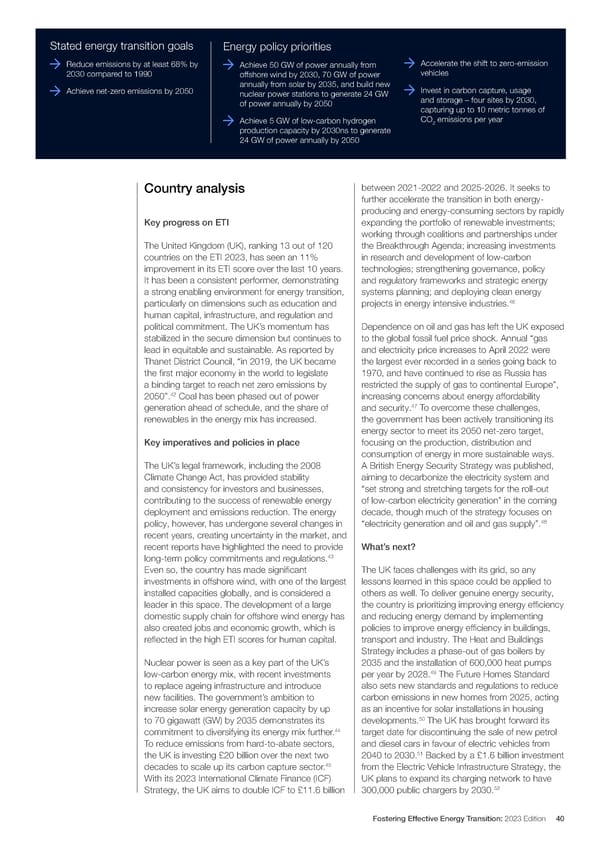Stated energy transition goals Energy policy priorities Accelerate the shift to zero-emission Reduce emissions by at least 68% by Achieve 50 GW of power annually from 2030 compared to 1990 offshore wind by 2030, 70 GW of power vehicles Achieve net-zero emissions by 2050 annually from solar by 2035, and build new Invest in carbon capture, usage nuclear power stations to generate 24 GW and storage – four sites by 2030, of power annually by 2050 capturing up to 10 metric tonnes of Achieve 5 GW of low-carbon hydrogen CO2 emissions per year production capacity by 2030ns to generate 24 GW of power annually by 2050 between 2021-2022 and 2025-2026. It seeks to Country analysis further accelerate the transition in both energy- producing and energy-consuming sectors by rapidly Key progress on ETI expanding the portfolio of renewable investments; working through coalitions and partnerships under The United Kingdom (UK), ranking 13 out of 120 the Breakthrough Agenda; increasing investments countries on the ETI 2023, has seen an 11% in research and development of low-carbon improvement in its ETI score over the last 10 years. technologies; strengthening governance, policy It has been a consistent performer, demonstrating and regulatory frameworks and strategic energy a strong enabling environment for energy transition, systems planning; and deploying clean energy particularly on dimensions such as education and 46 projects in energy intensive industries. human capital, infrastructure, and regulation and political commitment. The UK’s momentum has Dependence on oil and gas has left the UK exposed stabilized in the secure dimension but continues to to the global fossil fuel price shock. Annual “gas lead in equitable and sustainable. As reported by and electricity price increases to April 2022 were Thanet District Council, “in 2019, the UK became the largest ever recorded in a series going back to the 昀椀rst major economy in the world to legislate 1970, and have continued to rise as Russia has a binding target to reach net zero emissions by restricted the supply of gas to continental Europe”, 42 Coal has been phased out of power increasing concerns about energy affordability 2050”. generation ahead of schedule, and the share of 47 To overcome these challenges, and security. renewables in the energy mix has increased. the government has been actively transitioning its energy sector to meet its 2050 net-zero target, Key imperatives and policies in place focusing on the production, distribution and consumption of energy in more sustainable ways. The UK’s legal framework, including the 2008 A British Energy Security Strategy was published, Climate Change Act, has provided stability aiming to decarbonize the electricity system and and consistency for investors and businesses, “set strong and stretching targets for the roll-out contributing to the success of renewable energy of low-carbon electricity generation” in the coming deployment and emissions reduction. The energy decade, though much of the strategy focuses on 48 policy, however, has undergone several changes in “electricity generation and oil and gas supply”. recent years, creating uncertainty in the market, and recent reports have highlighted the need to provide What’s next? 43 long-term policy commitments and regulations. Even so, the country has made signi昀椀cant The UK faces challenges with its grid, so any investments in offshore wind, with one of the largest lessons learned in this space could be applied to installed capacities globally, and is considered a others as well. To deliver genuine energy security, leader in this space. The development of a large the country is prioritizing improving energy ef昀椀ciency domestic supply chain for offshore wind energy has and reducing energy demand by implementing also created jobs and economic growth, which is policies to improve energy ef昀椀ciency in buildings, re昀氀ected in the high ETI scores for human capital. transport and industry. The Heat and Buildings Strategy includes a phase-out of gas boilers by Nuclear power is seen as a key part of the UK’s 2035 and the installation of 600,000 heat pumps 49 low-carbon energy mix, with recent investments per year by 2028. The Future Homes Standard to replace ageing infrastructure and introduce also sets new standards and regulations to reduce new facilities. The government’s ambition to carbon emissions in new homes from 2025, acting increase solar energy generation capacity by up as an incentive for solar installations in housing 50 to 70 gigawatt (GW) by 2035 demonstrates its developments. The UK has brought forward its 44 target date for discontinuing the sale of new petrol commitment to diversifying its energy mix further. To reduce emissions from hard-to-abate sectors, and diesel cars in favour of electric vehicles from 51 Backed by a £1.6 billion investment the UK is investing £20 billion over the next two 2040 to 2030. 45 from the Electric Vehicle Infrastructure Strategy, the decades to scale up its carbon capture sector. With its 2023 International Climate Finance (ICF) UK plans to expand its charging network to have 52 Strategy, the UK aims to double ICF to £11.6 billion 300,000 public chargers by 2030. Fostering Effective Energy Transition: 2023 Edition 40
 Fostering Effective Energy Transition 2023 Page 39 Page 41
Fostering Effective Energy Transition 2023 Page 39 Page 41